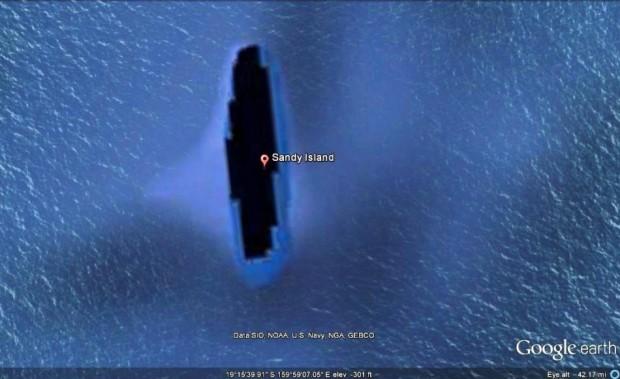Australian scientist discovers South Pacific island isn’t real
Sandy Island is a black hole on Goolge Maps, but it’s really just a further expanse of water in the Coral Sea. (Photo courtesy of Google Maps.)
When you call up the Coral Sea on Google Maps, there’s a curious black blob in the middle of the water.
An Australian scientist, Maria Seton, recently sailed to the spot to see if she could solve the mystery.
“We were wondering what this big, black blob was doing there so that’s why we asked the captain to change the course just a little bit so we could travel through the island, this supposed island,” she said.
The island, at least according to some maps, is known as Sandy Island.
Historically speaking, maps are works-in-progress. They have to be constantly updated and revised to reflect changing borders or new place names.
But in this era of satellite photos, and Google Earth, it’s very rare to find actual cartographic errors. It turns out, that’s exactly what Sandy Island is, however.
Seton and other researchers were studying plate tectonics underneath the Coral Sea, when they decided to move in closer to investigate this mysterious black hole on Google Earth.
“We were actually out in the eastern Coral Sea conducting a scientific research expedition and when we were approaching the area of this supposed island,” Seton said. “We saw that our scientific maps showed there was an island there and yet the navigation charts on board the vessel showed that we had a water depth of 1400 meters. So that’s when we started getting suspicious.”
Those 1400 meters are approximately 4600 feet, or slightly less than a mile of water beneath the boat. But that’s still deep seawater.
Seton double-checked her GPS location and sure enough, they were right where her maps showed an island, only there was no island — just the deep Coral Sea.
So what happenned to Sandy Island? One theory is there used to be a volcanic island there that somehow became submerged.
But Seton isn’t buying that.
“It definitely hasn’t disappeared. We believe that there was just never an island there,” Seton said. “All the navigation charts on board and all the ships that have gone through the area in the past and taken depth readings haven’t found that there’s an island there. It must have just been an error that has been propagated through these world maps.”
Seton says that it’s not really within a human timescale to see this island entirely shift or change to the point it disappeared.
“It’s still a bit of a mystery how this error was propagated,” she said.
We want to hear your feedback so we can keep improving our website, theworld.org. Please fill out this quick survey and let us know your thoughts (your answers will be anonymous). Thanks for your time!
